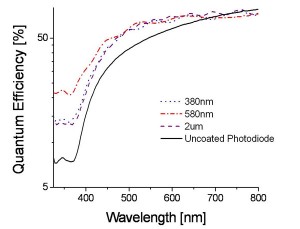Quantum Dot-based Anti-reflective Coatings for Silicon Photodiodes

Figure 1: Experimental data for device’s external quantum efficiency as a function of wavelength. Responsivity of the photodiode is significantly increased in the UV and across the visible spectrum, allowing for better light-coupling with the device and overall improvement in photocurrent density.
Silicon has been the material of choice for large-scale photovoltaics manufacturing due to cost and existing infrastructure and knowledge. Enhancements to the photocell design have been realized through modifications to the active area surface, use of optical-concentration mechanisms, and anti-reflective coatings. Anti-reflective coatings work by reducing the amount of reflected light at the interface through graded index-layering. Silicon has a high reflection coefficient in the UV part of the spectrum and hence low responsivity. We desire to capture this energy and couple the light into the photovoltaic for conversion into electricity. Past research has included investigation of photoluminescent anti-reflective coatings using organics [1]. These luminescent anti-reflection layers absorb in the UV part of the spectrum and demonstrate visible emission, helping to couple light into the active region. Quantum dots offer a similar solution absorbing strongly in the UV and emitting in the visible range, where silicon exhibits a reduced reflectivity and a concomitant increase in responsivity. In this work, CdSe quantum dots in a polymer and toluene solution spin-coated and cured on commercially available ‘red-enhanced’ silicon photodiodes increase photodiode responsivity in the UV compared to that of the original ‘red-enhanced’ photodiode. Moreover, an increase in the short-circuit photocurrent density by 3% was observed, Figure 1. Application of the coating can be used as a cost-effective solution to enhancing standard silicon photovoltaic performance through the post-processing addition of a luminescent anti-reflective layer.
References
- D. Z. Garbuzov et al., “Organic films deposited on Si p-n junctions: Accurate measurements of fluorescence internal efficiency, and application to luminescent antireflection coatings” Journal of Applied Physics, vol. 80, pp. 4644-4648, Oct 1996. [↩]
